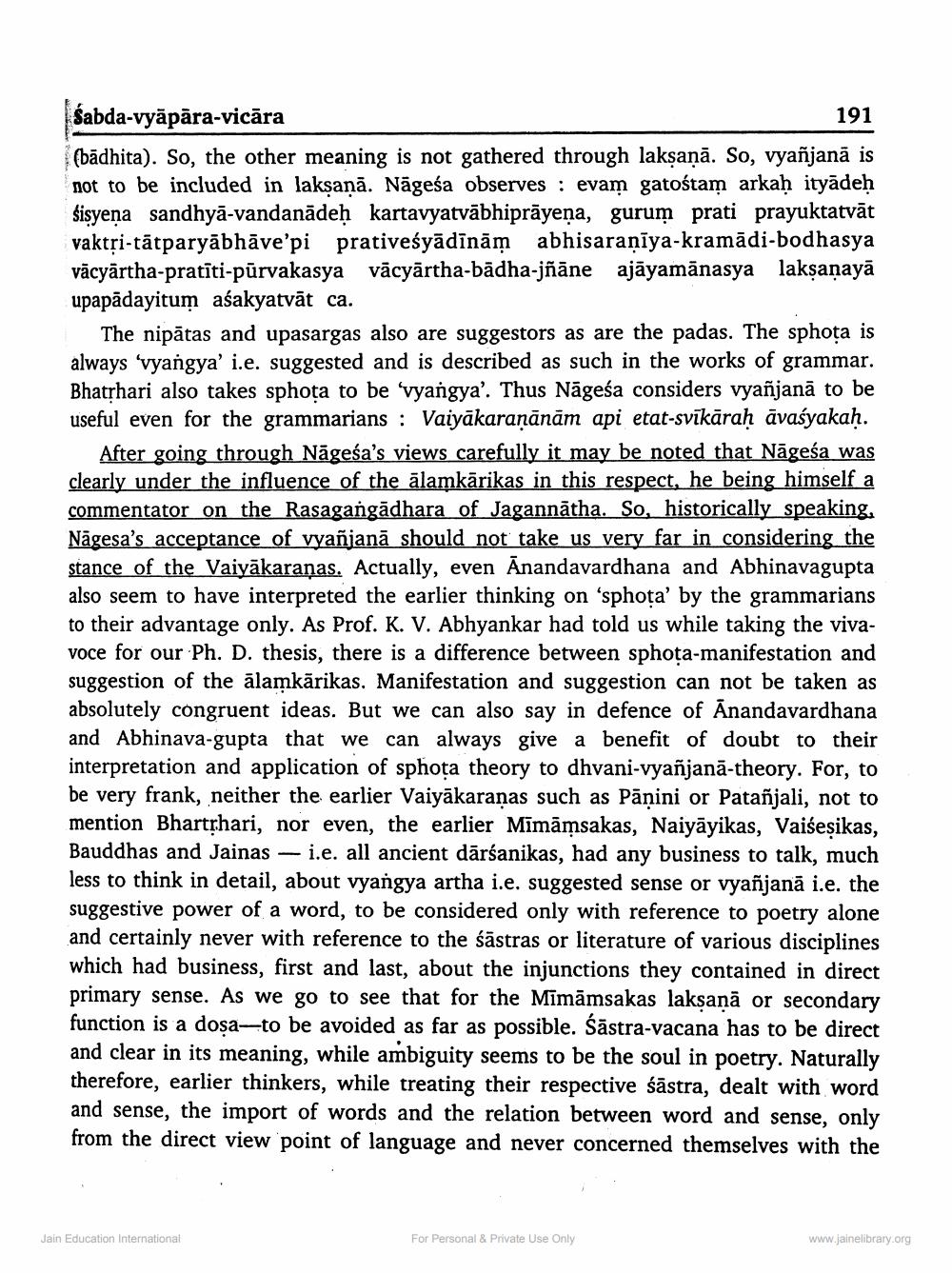________________
Sabda-vyāpāra-vicāra
191
(badhita). So, the other meaning is not gathered through lakṣaṇā. So, vyañjanā is not to be included in lakṣaṇā. Nāgeśa observes: evam gatostam arkaḥ ityādeḥ śisyena sandhyā-vandanādeḥ kartavyatvābhiprāyeṇa, gurum prati prayuktatvāt vaktṛi-tātparyābhāve'pi prativeśyādīnām abhisaraṇīya-kramādi-bodhasya vacyārtha-pratīti-pūrvakasya vācyārtha-badha-jñāne ajāyamānasya lakṣaṇayā upapādayitum aśakyatvāt ca.
The nipātas and upasargas also are suggestors as are the padas. The sphota is always 'vyangya' i.e. suggested and is described as such in the works of grammar. Bhatṛhari also takes sphota to be 'vyangya'. Thus Nāgeśa considers vyañjanā to be useful even for the grammarians: Vaiyākaraṇānām api etat-svīkāraḥ āvaśyakaḥ.
After going through Nageśa's views carefully it may be noted that Nageśa was clearly under the influence of the ālamkārikas in this respect, he being himself a commentator on the Rasagangadhara of Jagannātha. So, historically speaking, Nāgesa's acceptance of vyañjanā should not take us very far in considering the stance of the Vaiyākaraṇas. Actually, even Anandavardhana and Abhinavagupta also seem to have interpreted the earlier thinking on 'sphota' by the grammarians to their advantage only. As Prof. K. V. Abhyankar had told us while taking the vivavoce for our Ph. D. thesis, there is a difference between sphota-manifestation and suggestion of the ālamkarikas. Manifestation and suggestion can not be taken as absolutely congruent ideas. But we can also say in defence of Anandavardhana and Abhinava-gupta that we can always give a benefit of doubt to their interpretation and application of sphota theory to dhvani-vyañjanā-theory. For, to be very frank, neither the earlier Vaiyākaraṇas such as Pānini or Patañjali, not to mention Bhartṛhari, nor even, the earlier Mīmāmsakas, Naiyāyikas, Vaiśeṣikas, Bauddhas and Jainas i.e. all ancient dārśanikas, had any business to talk, much less to think in detail, about vyangya artha i.e. suggested sense or vyañjana i.e. the suggestive power of a word, to be considered only with reference to poetry alone and certainly never with reference to the śastras or literature of various disciplines which had business, first and last, about the injunctions they contained in direct primary sense. As we go to see that for the Mīmāmsakas lakṣaṇā or secondary function is a dosa-to be avoided as far as possible. Śastra-vacana has to be direct and clear in its meaning, while ambiguity seems to be the soul in poetry. Naturally therefore, earlier thinkers, while treating their respective śāstra, dealt with word and sense, the import of words and the relation between word and sense, only from the direct view point of language and never concerned themselves with the
Jain Education International
For Personal & Private Use Only
www.jainelibrary.org




